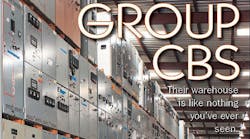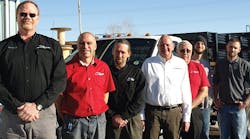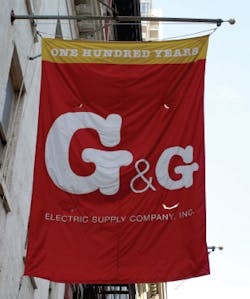Electrical distributors who thrive in Manhattan are a different breed. They are first and above all survivors. In the past 15 years, they survived Hurricane Sandy, which shut off power to an estimated 200,000-plus customers in Manhattan, and many times that number in the city’s four other boroughs. They survived the horrors of 9/11 and a recession that decimated Wall Street’s financial industry with mass layoffs. On top of these crises, they must deal with the day-to-day aggravation of traffic jams, subway delays, garbage strikes, panhandlers and daredevil bicycle messengers.
To survive in New York is to adapt, day-by-day, minute-by-minute. Need to deliver an order uptown but traffic is snarled? Get a warehouse guy to hop on the subway to make the delivery. Subway all messed up? Maybe the bus is running faster that day to get to that neighborhood.
For New Yorkers like Larry Heimrath and Joe Fusco of 100-year-old G&G Electric Supply, there’s no other place in the world to live or work. These are guys who didn’t have electricity after Hurricane Sandy in 2012 but managed to find a generator and installed a temporary power and lighting system so they could serve customers. They even set up a charging station on the sidewalk in front of their headquarters on 24th St. in New York’s trendy Chelsea neighborhood so nearby businesses and residents could charge up their phones and other electronic equipment.
After Con Edison got the power flowing again, Fusco, Heimrath’s nephew and the fourth generation in the family-owned business, says G&G Electric was open seven days a week for at least a month and a half, from 6 a.m. often until midnight. And when Fusco, the company’s president, did get home to Staten Island, it was to a packed house. His mother and grandmother were flooded out of their homes and lived with his family for months.
Heimrath and Fusco know the city block-by-block and can tell you which buildings are being converted into high-end condos or new office space with the latest in lighting control and low-voltage wiring networks; which cross-streets have the best parking spots; and the best places to eat in each of the five boroughs.
Heimrath, G&G’s chairman, was in software development with Marsh & McLennan before buying G&G Electric Supply in 1985 with his father, Erwin Heimrath. He is a born raconteur who loves to tell tales of living and working in New York, and for the past 20 years has commuted by bicycle to G&G Electric from his beloved Brooklyn — even during the aftermath of Hurricane Sandy, when the stoplights weren’t working, and bicycling through traffic was a bit dicey.
Larry can tell you stories about working in off-Broadway theater with Robert De Niro, or about the time he crashed his bicycle in Brooklyn and the first person who came to his rescue while he was lying on the pavement was the then relatively unknown Spike Lee. He and Joe can also tell some fascinating and at times hilarious stories about how G&G Electric has grown over the past few decades from a company that in its early history supplied electrical products for the building of the Empire State Building and Radio City Music Hall, to a distributor of cutting-edge LED lighting products and control systems, voice-data-video (VDV) equipment, and a package of elevator maintenance supplies.
Joe Fusco was a union plumber when Larry spotted leadership talent in his nephew and convinced him to join the company in 1993 so he could groom him to become president. Fusco brought a tried-and-true business principle from the plumbing field that works in any distribution trade. “Just being on the opposite side of the counter, I always knew what you needed — speed,” he says. “The faster you can get in the faster you can get out.” He also liked the way plumbing distributors gave their counter customers sturdy plastic carrying bags for their purchases, and G&G offers similar bags to its customers with the well-marketed G&G logo on them.
Expanding the Business
With his background in construction, Fusco manages many of the construction projects related to the company’s growth, including its move in 1994 to its present location, which had been a Dykes Lumber yard; the purchase of additional warehouse space in the Bronx; and the company’s new branch in Harlem, which opened during the past year.
The move to the current headquarters from around the corner was a milestone, because it gave the company the capacity to expand. The location also offered a resource that’s tough to find in Manhattan — on-street parking. Explains Heimrath, “We are very lucky. Twenty-Fourth St. is capped on one side by Madison Square Park and on the other by a post office on 11th Ave. It’s not a through street. You can park more easily on the street.”
G&G Electric had reached about $4 million in sales in its old location, but to grow more they were going to need additional space, because the old location only had 2,500 square feet on the main floor. “We had no places to put the material coming,” says Heimrath. “You don’t need a consultant to tell you when you need more space. But the search for space took us almost two years before we acquired this building. Joe had two months to prepare this building. We opened up in 62 days during Christmas of 1994. It was more space than we could ever imagine having. I thought, ‘How could we ever fill up all this space?’”
G&G Electric’s growth since that move is impressive. The company, which celebrated its 100th anniversary with a big party earlier this month, hit $32.9 million in 2013 sales and was ranked #155 on Electrical Wholesaling’s 2014 Top 200 listing. Heimrath says it was always a goal of his to make the EW Top 200. “We are the largest supplier on the island itself,” he says proudly. “Companies have been coming to us for a hundred years.”
When you visit G&G Electric, it’s not unusual to see warehouse workers on West 24th St. breaking down a pallet of electrical products before storing them in the warehouse. Their Chelsea neighborhood is in many ways emblematic of the changes reshaping New York. Chelsea was once an edgy garment district where clothing manufacturers provided the latest styles to New York’s fashion industry. A few blocks away from G&G Electric is the famed Hotel Chelsea, where many famous writers and rock stars were residents, including Mark Twain, Bob Dylan, Allen Ginsberg, Arthur Miller, Janis Joplin and Sid Vicious.
The neighborhood now has a more gentrified feel, with several Starbuck’s coffee shops, a Whole Foods supermarket and a Jamba Juice store, as well as all sorts of residential and commercial construction projects reshaping the look and feel of the cityscape and providing its customers with work.
With all of its recent growth, G&G Electric is running tight on warehouse space again. Along with supplying construction projects in Chelsea and other parts of Manhattan, the company serves customers working in New York’s outer boroughs, too, and several years ago Fusco and Heimrath started looking to expand the business outside of Manhattan. Warehouse space is tough to find in New York because so many buildings are being converted to condos, and many of the industrial properties that do come on the market have severe environmental issues that must be remediated. Heimrath says two warehouses they considered buying had environmental problems. “One place used to make pipe nipples,” he says. “We loved the place and we loved the location in Brooklyn. The problem was that between 1960-1990, any company cutting metal like that also used PCBs, and not all of it was handled properly. So you need remediation of the soil. You can spend a million fixing that.”
Prices for New York industrial properties have soared in recent years, and Heimrath and Fusco can tell you stories about New York distributors who own buildings worth more than the businesses themselves. “You may have had a building that wasn’t worth anything but now you are rich,” Heimrath says.
After looking for a warehouse for three years, when they found a former bakery in the Bronx with a relatively clean bill of health, they jumped on it. The new warehouse is in an area of New York that the state and city are trying to develop, so G&G was able to get some tax breaks through the New York City Industrial Development Agency. We are very into the game,” says Heimrath. “We are city guys so we know the city street-by-street. This place we knew was accessible to the city (Manhattan). We knew the traffic patterns. “
Their street smarts also paid off when they learned that the owners of Captre Electrical Supply wanted to sell their business, located on 125th St. in Harlem. Fusco said they bought the assets of the business and opened up the location just three weeks after first learning about it. To modify the branch to their liking in such a short time was a “miracle,” he says.
Heimrath and Fusco are considering other ways to expand, possibly by acquiring another family-owned business. “There are supply houses around who don’t have an heir-apparent to take over, or they are in trouble themselves,” says Heimrath. “It’s increasingly hard to compete. We see opportunity there.”
Building a Computer System
While some competitors may not be able to afford the cost of new software, G&G’s home-grown software has thus far kept pace with the needs of the expanding business. The company has taken an interesting route in the development of its software. Instead of buying a standard distribution package, the company took advantage of Heimrath’s background in computers at Marsh & McLennan and the computer programming skills of his brother-in-law, the late Steve Egger, and developed their own.
Heimrath says the journey started when he programmed an old Compaq computer to handle pricing. “When I started with my father, he did all the pricing in his head,” he says. “But if we had cash sales coming in, he couldn’t go out for lunch because there was no one to do pricing. I thought it was crazy. The computer was a 40-pound device and I had to carry it and program it at night. I first set it up so I could key in an item so I could see what the price was.”
While his father Erwin was initially unimpressed with his son’s computer expertise and called the Compaq computer as “that stupid computer on the desk,” Larry remembers the day when Erwin saw his son could get prices from the computer and to customers almost as fast as he could and said, “When do I get one of those things?”
“This was only 1985-1990,” Heimrath says. “It was our first growth spurt, and as we computerized more we found ourselves ahead of our competition. We handled greater volume at a lesser cost.”
But he was getting tired of lugging around the Compaq computer everywhere (even to Europe while vacationing in Spain and Paris). He decided to talk with his brother-in-law Steve, a New York City detective who had gone to school at night to learn computers and developed a computer system for the New York Police Department that helped map crimes so they would know where to deploy people. Steve was tiring of detective work and wanted to get more into computers, Heimrath says. “I said in 1996, ‘If you really want to do computer stuff, I will give you something to do.’ Whatever I could imagine he could build. It really helped sustain our growth.”
One feature they custom designed for the counter area is a two-screen system where the customer sees exactly whatever product the counter person looks up. This saves the counter worker from having to swing his screen over to customers. They also loaded their product records with images, because many of their customers aren’t fluent in English and find it easier to identify electrical products by image.
Down the Road
Heimrath says two factors that have helped the company grow is their ability to customize their computer system to their business needs and the fact that they own their headquarters location and have not been forced out of Manhattan by high rents. “Since we owned the real estate we had solved the problem of being able to exist here in Manhattan,” says Heimrath. “Other people were selling their buildings and moving out to the boroughs.”
He says competitors who make that move can’t service customers nearly as well because of the colossal hassles of mid-day traffic. “To get off this island in the middle of the day to pick up a circuit breaker is insanity,” he says.
Another challenge is keeping their employees up-to-speed with all of the technological changes in lighting control, LEDs and building automation systems, which have all become commonplace in the high-rise office towers and luxury condo projects they service. Heimrath and Fusco say many of their younger customers are all over the new technology — in particular the growing number of electricians who have emigrated from Russia and Eastern Europe with advanced technical degrees.
Serving customers whose native language is something other than English is nothing new for the folks at G&G. When you visit the company’s counter you may hear customer placing orders in broken English blended with Spanish, Russian and Chinese and other languages. Figuring out how to best communicate with all of these customers is part of the fun and challenge of being a growing distributor in the Big Apple.














